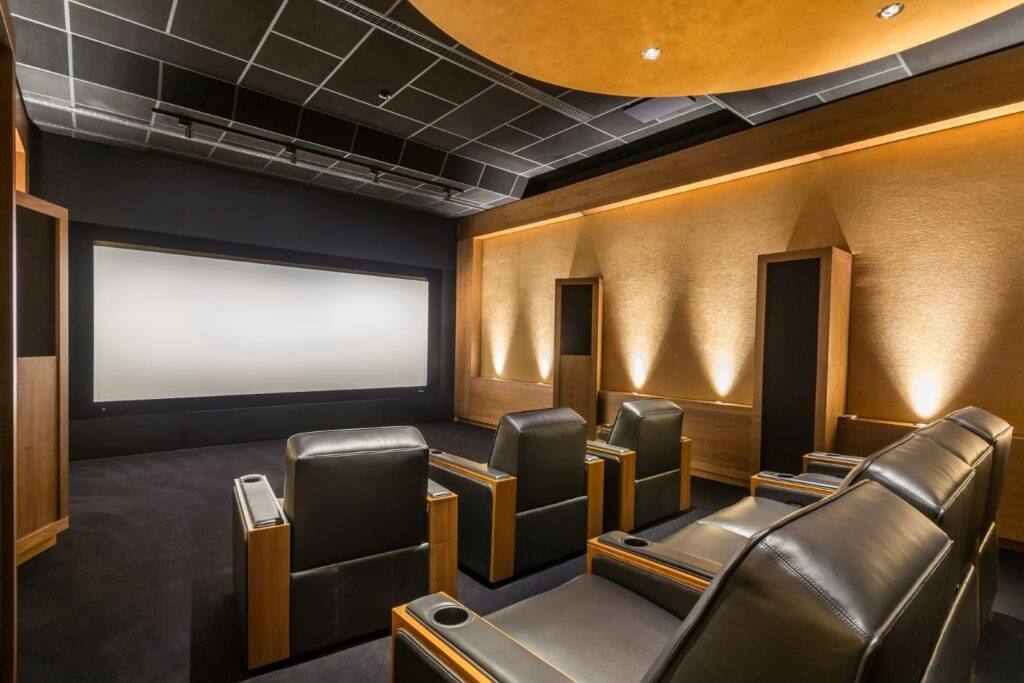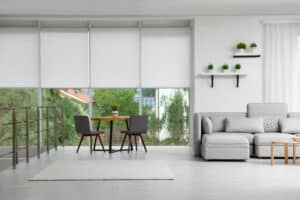There’s nothing quite like settling into your home theater chair at night, grabbing the popcorn, and watching your favorite movie. But what if your home theater experience could be even better? What if you could get rid of those pesky echoes or improve the sound quality no matter where you sit in the room? It may sound like something out of a science fiction movie, but with the help of AIS, it’s easier than you think to achieve home theater acoustics that will make you feel as if you are right in the middle of the action.
Home Theater Acoustics (And Why It Matters)
Home theater acoustics is the combination of your room shape along the number and type of speaker to create the perfect sound experience. While some people opt for a sound bar to stand in for their speaker system, only the true home theater crowd would go all out creating the perfect acoustic setup.
Even the smallest adjustment can change the acoustics in the room, so make sure every piece is as perfectly placed as possible. There are many different reflections (hard items sound bounces off of) in a room that change the tone of a sound, which drastically changes how the viewer receives it.
Acoustics, Sound Proofing, and Sound Dampening
Theater acoustics differ from sound proofing and sound dampening in how they trap the sound and by how much. Acoustic panels and treatments are typically not used to soundproof a room or even dampen the sound because the panels are meant to create the perfect harmony or sound inside of a room instead of trapping or blocking noises out.
Acoustics vs Sound Proofing
Sound proofing uses thick heavy materials to create barriers (whether inside the walls or on them) so no sound goes out and no sound comes in. Because of how sound proofing differs from cinema acoustics, it is beneficial to have both in your theater for the best experience.
Acoustics vs Sound Dampening
Another similar and commonly interchangeable term is sound dampening. Sound dampening is when you add extra cushion such as blankets, pillows, or rugs in the hopes of reducing the level of noise traveling in or out of that room. Because this method is just applying extra layers in order to reduce noise, it is going to be the least successful in blocking out all sound.
What affects your home theater’s acoustics?
Because home theater acoustics are so sensitive, even the smallest adjustments can change the dynamic. To get started, these are 4 main components that affect how to acoustically treat a room:
- Room dimensions: Room dimensions are a huge factor when thinking about cinema acoustics. Ideally, you want a rectangular room for your theater so that everything is properly spaced out. If you have a square or L shaped room, you may want to think about switching rooms for your home theater.
- Floor material: For the best results, use carpet for the flooring since it will absorb excess sounds compared to a hardwood or tile floor which will cause echoing.
- Windows/Doors: Having a window or glass door facing the outside will make it harder to get the best acoustic sound since that noise can come in more easily to disrupt the balance. If your home theater has glass doors in it, consider switching rooms for better acoustic sound.
- Wall Space: Where you place absorption panels on the wall also has a lasting effect on home theater acoustics. To find the best placement, try the mirror trick to find the exact spot that the sound is bouncing off of.
Types of Acoustic Treatments for Home Theaters
To create the perfect home theater acoustic system, choose which of the following treatments work best for your set up and what you can live without. Absorption helps reduce the echos, but only having absorption makes the space too silent so to give the room some movement again, use diffusers to scatter some of the reflective sounds in the right way.
New Construction Options
Since the house is still under construction, most of the equipment can be built into the walls to have a more complete look. One way to help soundproof and help your acoustics would be the IsoMax sound isolation clips. These clips get put in the ceiling before the drywall and help reduce the noise traveled between the levels.
Typically, the isolation clips are perpendicular to the studs and would trap the sounds between the rods and dissipate from there. Because this is built in, it should be decided early on into construction so it can be done properly and at the lowest cost.
Retrofit Options
For a more retro option, soundproofing drywall and soundproof floors are optimal for redoing a room as a theater to have extra hidden cushioning. This option is great if the room has hardwood floors so there is still absorption for the sound underneath.
Adding carpet, blankets, pillows or anything else soft will increase the amount of absorption in the room. Aim for about 80 percent absorption rate for theater acoustics to have a healthy balance of absorption/diffusion.
Bookshelves, end tables, wall frames etc. will increase the amount of diffusion in a room and help add sound back to the theater. Hard surfaces allow sound to reflect off and if done correctly, can make the acoustics all in perfect harmony.
Wall Options
- Wall Absorption Panels: These go on the wall where the sound from the speakers bounces off to help direct the sound to the seating, as well as causing less echo. Try the mirror test to see exactly where to put them and how many you need for the ultimate set up. These panels can also be custom printed to match any design for the perfect look.
- Diffusers: These are essential if you have lots of panels. What a diffuser does is help bring some of the sound back, but in the right tone and amount. It helps trap and disperse some of the sound waves back to you to keep the room from being too quiet or sterile. Most of the diffusers will be made from a hard material such as wood, metal, or ceramics.
Floor/Ceiling Options
- Bass Traps: Bass traps are arguably the most important piece in a home theater system. These devices trap any low bass note reflections in it so there are no vibrations back at you. For the best results, start by putting the bass traps into the corners and adding more from there.
- Ceiling panels: These are just like wall panels but are mounted to the ceiling for added absorption. Ceiling panels are less important than the other options, but if the ultimate home theater acoustics are your goal, then these are a must. Be sure to add extra mounting support since ceiling panels will be hanging above you.
Tips for Optimizing the Acoustics in your Home Theater
- Angle speakers towards the seats
- Reduce noise outside of the room
- Use blackout curtains for sound absorption as well as keeping the room dark
- Add furniture, throw blankets, and a rug if you have hardwood or tile floors for less echo
So, what does all this mean for you and your home theater? It means that if you want the best possible experience, you need to take acoustics into account. The good news is that there are plenty of things you can do to optimize the acoustics in your space, and our team at Advanced Integrated Systems is here to help. Contact us today to learn more about how we can help you create the perfect home theater environment.
Start planning your home theater with our budget calculator tool.




